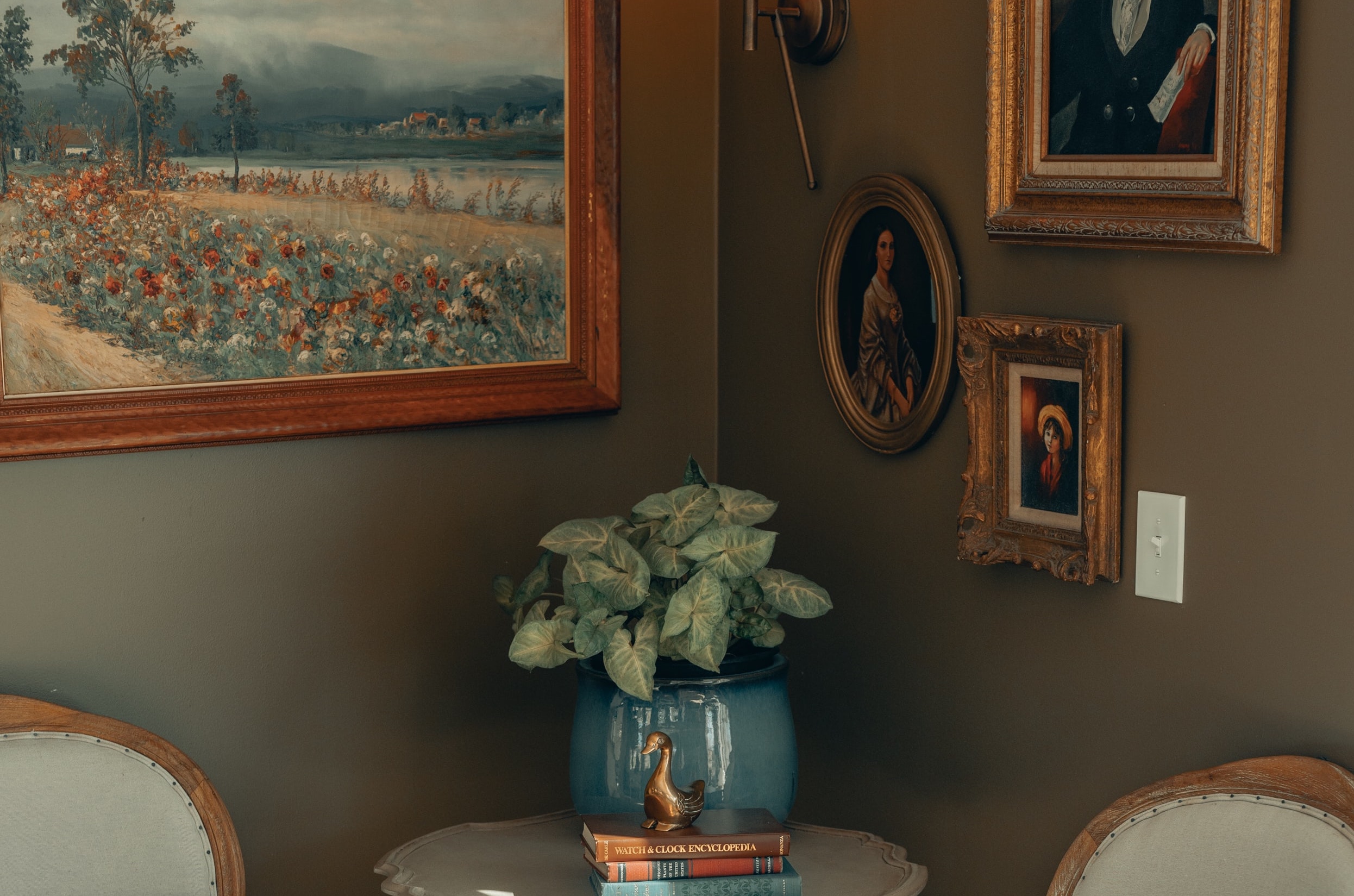
In Islam it is desirable not to hinder the angels from entering the house. Some angels are responsible for conveying mercy, goodness and supplications. Muslims would therefore not want to miss this opportunity.
 The Prophet (ﷺ) said:
"There are no people who remember Allah in a gathering except that there are angels around them who bring them mercy and tranquility and mention them to Allah."
[Sahih Muslim 2700a]
The Prophet (ﷺ) said:
"There are no people who remember Allah in a gathering except that there are angels around them who bring them mercy and tranquility and mention them to Allah."
[Sahih Muslim 2700a]
There are narrations indicating that the angels (of mercy) do not enter the house that has an image in it.
But what images are we talking about? The Sunnah indicates that these are images of living beings with souls. So displaying other images like trees, landscapes and the like is not wrong.
 Ibn Abbas reported:
"Abu Talhah (one of the best Sahaba) related to me that the Prophet said, "Angels do not enter the house in which there is a dog or image." Abu Talhah added, "He (ﷺ) meant images of creatures with a soul.""
[Sahih al-Bukhari 4002]
Ibn Abbas reported:
"Abu Talhah (one of the best Sahaba) related to me that the Prophet said, "Angels do not enter the house in which there is a dog or image." Abu Talhah added, "He (ﷺ) meant images of creatures with a soul.""
[Sahih al-Bukhari 4002]
Objects that are given a respectable and honorable position in the house should not contain images of living beings. This is frowned upon in Islam.
Curtains, clothing, paintings, drawings or posters should therefore not depict animals or people.
 Abu Hurairah reported:
“Jibril stood at the door of the Prophet (ﷺ) and he (ﷺ) gave permission to enter. Then Jibril said to the Prophet (ﷺ): “How can I enter the house if you have a curtain with pictures on it? You should remove the head from those pictures or change that curtain to a rug, because we angels do not enter a house that has pictures on it."
[Sunan an-Nasaee 5365]
Abu Hurairah reported:
“Jibril stood at the door of the Prophet (ﷺ) and he (ﷺ) gave permission to enter. Then Jibril said to the Prophet (ﷺ): “How can I enter the house if you have a curtain with pictures on it? You should remove the head from those pictures or change that curtain to a rug, because we angels do not enter a house that has pictures on it."
[Sunan an-Nasaee 5365]
 Aisha narrated:
I decorated a closet with a rug with images of winged horses on it. the Prophet (ﷺ) entered and removed it. Then I ripped that rug and used it to make two cushions. The Prophet (ﷺ) used these cushions to lean on at home.
[Sahih al-Bukhari 2479, Sahih Muslim 2107f]
Aisha narrated:
I decorated a closet with a rug with images of winged horses on it. the Prophet (ﷺ) entered and removed it. Then I ripped that rug and used it to make two cushions. The Prophet (ﷺ) used these cushions to lean on at home.
[Sahih al-Bukhari 2479, Sahih Muslim 2107f]
 (12) حدثنا أبو بكر قال حدثنا عبد الرحيم بن سليمان عن عبد الملك عن عطاء في التماثيل، ما كان مبسوطا يوطأ ويبسط فلا بأس به، وما كان ينصب فإني أكرهه.
(12) حدثنا أبو بكر قال حدثنا عبد الرحيم بن سليمان عن عبد الملك عن عطاء في التماثيل، ما كان مبسوطا يوطأ ويبسط فلا بأس به، وما كان ينصب فإني أكرهه.
المصنف - ابن أبي شيبة الكوفي - ج ٦ - الصفحة ٨٥
'Attaa said:
"As for images depicted on vast and simple objects, there is nothing wrong with that. I hate it when objects with pictures are honored."
[Musannaf Ibn Abi Shaybah 6/85]
 (3) حدثنا أبو بكر قال حدثنا ابن فضيل عن ليث قال: رأيت سالم بن عبد الله متكئا على وسادة حمراء فيها تماثيل فقلت له فقال: إنما يكره هذا لمن ينصبه ويصنعه.
(3) حدثنا أبو بكر قال حدثنا ابن فضيل عن ليث قال: رأيت سالم بن عبد الله متكئا على وسادة حمراء فيها تماثيل فقلت له فقال: إنما يكره هذا لمن ينصبه ويصنعه.
المصنف - ابن أبي شيبة الكوفي - ج ٦ - الصفحة ٨٤
Layth ibn Sa'd overleverde:
"I saw Salim ibn Abdullah (grandson of Umar ibn al-Khattab) leaning on a red cushion on which there was an image, so I asked him about it. He then told me, 'This is only frowned upon for the one who honors objects with images or who makes this.""
[Musannaf Ibn Abi Shaybah 6/84]
This saying shows us that drawing images of living beings with souls is not allowed according to Islam. Making such images is a great sin.
 (5) حدثنا أبو بكر قال حدثنا ابن علية عن علقمة عن محمد بن سيرين قال: نبئت عن حطان بن عبد الله قال: أتى علي صاحب لي فناداني فأشرفت عليه فقال: قرئ علينا كتاب أمير المؤمنين يعزم على من كان في بيته ستر منصوب فيه تصاوير لما وضعه، فكرهت أن أحسب عاصيا، فقمنا إلى قرام لنا فوضعته، قال محمد: كانوا لا يرون ما وطئ وبسط من التصاوير مثل الذي نصب.
(5) حدثنا أبو بكر قال حدثنا ابن علية عن علقمة عن محمد بن سيرين قال: نبئت عن حطان بن عبد الله قال: أتى علي صاحب لي فناداني فأشرفت عليه فقال: قرئ علينا كتاب أمير المؤمنين يعزم على من كان في بيته ستر منصوب فيه تصاوير لما وضعه، فكرهت أن أحسب عاصيا، فقمنا إلى قرام لنا فوضعته، قال محمد: كانوا لا يرون ما وطئ وبسط من التصاوير مثل الذي نصب.
المصنف - ابن أبي شيبة الكوفي - ج ٦ - الصفحة ٨٤
Muhammad ibn Sireen narrated:
"The commander of the believers ordered the people to remove curtains that had images on them. So Hittan ibn Abdullah brought his curtain and put it in a storeroom. They (the people of that time) did not consider the stretched out or spread out objects with images like the objects that were hung."
[Musannaf Ibn Abi Shaybah 6/84]
Exceptions have been made for objects that are not respected or honored. Think, for example, of pillows and carpet.
Objects that lie along the floor and are not given a respectful position in the house are therefore an exception. These objects can have an image, without hindering the angels from entering the house.
 Aisha narrated:
"I decorated a cupboard with a cloth on which there were images of winged horses. The Prophet (ﷺ) came in and removed it. Then I tore that cloth and used it to make two cushions. The Prophet (ﷺ) used these cushions home to lean on."
[Sahih al-Bukhari 2479, Sahih Muslim 2107d]
Aisha narrated:
"I decorated a cupboard with a cloth on which there were images of winged horses. The Prophet (ﷺ) came in and removed it. Then I tore that cloth and used it to make two cushions. The Prophet (ﷺ) used these cushions home to lean on."
[Sahih al-Bukhari 2479, Sahih Muslim 2107d]
It is understood from this Hadith that hanging a cloth with pictures for decoration is not allowed. We can also see that it is not a bad thing to have pillows that contain images.
 (17) حدثنا أبو بكر قال حدثنا الحسن بن موسى قال حدثنا حماد بن سلمة عن عمرو بن دينار عن سالم بن عبد الله قال: كانوا لا يرون بما وطئ من التصاوير بأسا
(17) حدثنا أبو بكر قال حدثنا الحسن بن موسى قال حدثنا حماد بن سلمة عن عمرو بن دينار عن سالم بن عبد الله قال: كانوا لا يرون بما وطئ من التصاوير بأسا
المصنف - ابن أبي شيبة الكوفي - ج ٦ - الصفحة ٨٥
Salim ibn Abdullah (grandson of Umar ibn al-Khattab) said:
"They (the companions) would not mind having images on objects that are being stomped on."
[Musannaf Ibn Abi Shaybah 6/85]
 (9) حدثنا أبو بكر قال حدثنا ابن علية عن ابن عون قال: كان في مجلس محمد وسائد فيها تماثيل عصافير، فكان أناس يقولون في ذلك فقال محمد: إن هؤلاء قد أكثروا فلو حولتموها.
(9) حدثنا أبو بكر قال حدثنا ابن علية عن ابن عون قال: كان في مجلس محمد وسائد فيها تماثيل عصافير، فكان أناس يقولون في ذلك فقال محمد: إن هؤلاء قد أكثروا فلو حولتموها.
المصنف - ابن أبي شيبة الكوفي - ج ٦ - الصفحة ٨٥
Ibn 'Awn reported:
"We entered the seat of Muhammad ibn Sireen seeing a cushion on which a bird was depicted. The people objected to it, to which Muhammad said, "There are so many of these cushions now, just turn them over.""
[Musannaf Ibn Abi Shaybah 6/85]
 (10) حدثنا أبو بكر قال حدثنا ابن يمان عن عثمان بن الأسود عن عكرمة بن خالد قال: لا بأس بالصورة إذا كانت توطأ.
(10) حدثنا أبو بكر قال حدثنا ابن يمان عن عثمان بن الأسود عن عكرمة بن خالد قال: لا بأس بالصورة إذا كانت توطأ.
المصنف - ابن أبي شيبة الكوفي - ج ٦ - الصفحة ٨٥
Ikrimah said:
"There is nothing wrong with images when they are on extended or simple objects which are stamped on."
[Musannaf Ibn Abi Shaybah 6/85]
 (11) حدثنا أبو بكر قال حدثنا ابن يمان عن الربيع بن المنذر عن سعيد بن جبير قال: لا بأس بالصورة إذا كانت توطأ.
(11) حدثنا أبو بكر قال حدثنا ابن يمان عن الربيع بن المنذر عن سعيد بن جبير قال: لا بأس بالصورة إذا كانت توطأ.
المصنف - ابن أبي شيبة الكوفي - ج ٦ - الصفحة ٨٥
Sa'eed ibn Jubayr said:
"There is nothing wrong with images when they are on extended or simple objects which are stamped on."
[Musannaf Ibn Abi Shaybah 6/85]
 (12) حدثنا أبو بكر قال حدثنا عبد الرحيم بن سليمان عن عبد الملك عن عطاء في التماثيل، ما كان مبسوطا يوطأ ويبسط فلا بأس به، وما كان ينصب فإني أكرهه.
(12) حدثنا أبو بكر قال حدثنا عبد الرحيم بن سليمان عن عبد الملك عن عطاء في التماثيل، ما كان مبسوطا يوطأ ويبسط فلا بأس به، وما كان ينصب فإني أكرهه.
المصنف - ابن أبي شيبة الكوفي - ج ٦ - الصفحة ٨٥
'Attaa said:
"As for images depicted on vast and simple objects, there is nothing wrong with that. I hate it when objects with images are honored."
[Musannaf Ibn Abi Shaybah 6/85]
 (3) حدثنا أبو بكر قال حدثنا ابن فضيل عن ليث قال: رأيت سالم بن عبد الله متكئا على وسادة حمراء فيها تماثيل فقلت له فقال: إنما يكره هذا لمن ينصبه ويصنعه.
(3) حدثنا أبو بكر قال حدثنا ابن فضيل عن ليث قال: رأيت سالم بن عبد الله متكئا على وسادة حمراء فيها تماثيل فقلت له فقال: إنما يكره هذا لمن ينصبه ويصنعه.
المصنف - ابن أبي شيبة الكوفي - ج ٦ - الصفحة ٨٤
Layth ibn Sa'd reported:
"I saw Salim ibn Abdullah (grandson of Umar ibn al-Khattab) leaning on a red cushion on which there was an image, so I asked him about it. He then told me, 'This is only frowned upon for the one who honors objects with images or who makes this.""
[Musannaf Ibn Abi Shaybah 6/84]
 (4) حدثنا أبو بكر قال حدثنا ابن مبارك عن هشام بن عروة عن أبيه أنه كان يتكئ على المرافق فيها التماثيل: الطير والرجال.
(4) حدثنا أبو بكر قال حدثنا ابن مبارك عن هشام بن عروة عن أبيه أنه كان يتكئ على المرافق فيها التماثيل: الطير والرجال.
المصنف - ابن أبي شيبة الكوفي - ج ٦ - الصفحة ٨٤
Hisham ibn 'Urwah narrated from his father ('Urwah ibn al-Zubayr) that he saw him leaning on a pillow on which were pictures of birds and people.
[Musannaf Ibn Abi Shaybah 6/84]
Do you have questions that came to mind while reading our pages? Or do you have general questions that you would like an answer to? We answer you within 48 hours.
Ask question